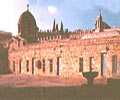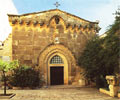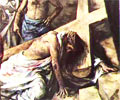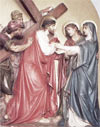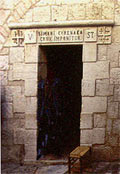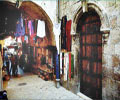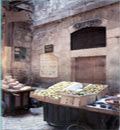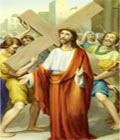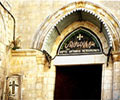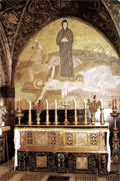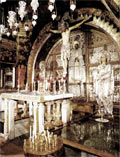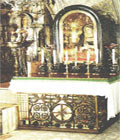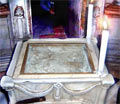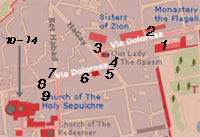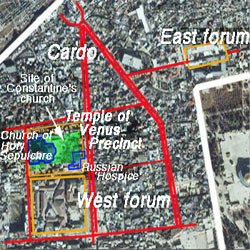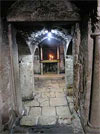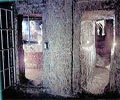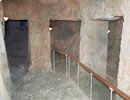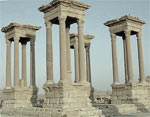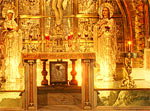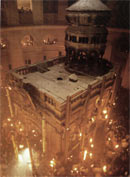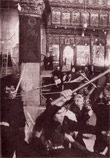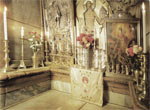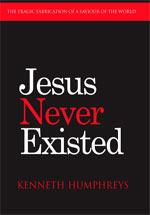1st Station
A madrasa! The al-Omariyyeh Islamic school occupies a former Ottoman army barracks built on the site of the Antonia Fortress. For centuries, belief but not facts maintained that Pontius Pilate had his "praetorium" here. It was actually on the west side of the Old City.
|
2nd Station
A Franciscan monastery offers the Chapels of the Condemnation and the Flagellation to get pilgrims off to a good start. From here Jesus was made to carry his cross. Well, that's the yarn.
|
3rd Station
The "falls of Jesus" are a good example how successive generations of Christians added to their favourite story. It seems reasonable that a man weakened by a severe whipping should fall, therefore it becomes a "tradition" and, with time, the "tradition" becomes accepted as "truth".
|
4th Station
Here we go again. Where was Mother Mary? Surely watching somewhere. Let's make it a tradition (and sell a few more trinkets).
|
5th Station
Did he or didn't he? "A certain man from Cyrene, Simon, the father of Alexander and Rufus, was passing by on his way in from the country, and they forced him to carry the cross." - Mark 15.21. "And He bearing His cross went forth into a place called the place of a skull." – John 19.17.
|
6th Station
Greek Orthodox shrine. Buy your holy hanky here! |
7th Station
All fall down. The Franciscans took possession of this chapel in 1875. Within are the remains of a large column of red stone coming from the tetrapylon of Aelia Capitolina.
|
8th Station
Jesus takes a break from agonizing torment to address the weeping women of Jerusalem.
|
9th Station
A crude cross on a Roman column marks the third "falling down" point. The intrepid pilgrim is now within sight of the big church. The excitement mounts.
|
10th and 11th Stations
The Catholic Chapel commemorates both the stripping station and the nailing station. Who can argue with that?
|
12th Station
The Greek Orthodox have managed to hang on to the big potato – the Crucifixion station.
|
13th Station
Between the 11th and 12th stations, the purported site of "taking down from the cross". Otherwise known as the altar of Our Lady of Sorrows (Stabat Mater), it is a novelty from the 16th century.
|
14th Station
Within the Edicule, an ante-chamber ("Chapel of the Angel") featuring the "Altar of the Rolling Stone." Heap big magic. |
Why waste a good yarn?
 Attis
Attis
"The cult of Cybele was well-known for its flagellant, mendicant priests and for the public ceremonies of 15-27 March when, after fasting and the Day of Blood (22 March) on which Attis was mourned, sorrow was turned into joy with the Hilaria celebrating his resurrection on 25 March (a striking parallel to the Christian Holy week and Easter)."
– Henry Chadwick, The Early Church, p24,25.
|
The streets of the Via Dolorosa were never traversed by Jesus, with or without his cross. The roads of the Old City of Jerusalem follow the line (but at a level some ten to fifteen feet higher) of the town built by the Roman Emperor Hadrian after 135 AD – a century too late for any Christian messiah. The "stations of the cross" along the pilgrim route – originally seven but now fourteen – are entirely bogus and have always served a liturgical and commercial purpose. Even the route itself, from west to east, is at odds with current New Testament scholarship which favours a short south-north route from the area of Herod's palace. Five of the current "stations" are actually within the Church of the Holy Sepulchre, which offers the curious tourist and the wide-eyed believer a rich assortment of religious memorabilia, little of which is ancient. In the marble floor of the Catholic chapel a star marks the very spot where Mary Magdalen received the news of the resurrection from an angel, a medieval innovation. A "stone of unction" near the main door, where Joseph of Arimathea anointed the Lord's body, was introduced by Crusaders in the 12th century. The latest chunk of red granite arrived in 1810 but it still gets kisses from the faithful. Even more startling, "Holy fire" descends each Easter into the sacred tomb, a "miracle" invented in the 9th century and yet the trick still delights the crowds. Protestants may blanch at the chicanery and sacrilege of it all but for the Catholic and Orthodox creeds the circus is living proof of their faith and unwavering testimony of the "historical Jesus".
Following the yellow brick road
Stations 1 and 2, which feature the drama of JC's trial, condemnation and flogging at the praetorium, are entirely at odds with the historical evidence. Such delights as the "Ecce Homo" arch (where Pilate allegedly said of Jesus "behold the man", John 19.5) and the "pavement" where Pilate's judgement seat was said to have been (the "lithostrotos" of John 19.13), have come back to haunt the glib assertions of Christian apologetics. These structures, long used to buttress claims of gospel veracity, are Hadrianic constructions. The Praetorium was never located in the Antonia fortress (so-named by Herod in honour of Mark Antony) which stood by the northwest corner of Temple Mount. The Antonia was far smaller than is often supposed. Josephus repeatedly refers to it as "the tower Antonia" and relates that it was originally built by the first of the high priests called Hyrcanus for safekeeping the holy vestments (Ant. 18.4.3). A modern archaeologist concurs:
The pagan emperor would have laughed his socks off!
All fall down The gospels make NO mention of Jesus falling three times (Stations 3, 7 and 9), no meeting with his mother Mary (Station 4), and no encounter with a woman named Veronica (Station 6). They are, in the parlance of religious chicanery, "devotional" embellishments. Even more farcical is the "prison of Christ", close by the Convent of the Sisters of Zion, where the Lord was held for questioning. Not only is the "cell" medieval (the claim dates from 1911!) but it competes with another (equally bogus) "prison of Christ" within the Church of the Holy Sepulchre and a third in the so-called "house of Caiaphas" on Mount Sion! Jesus - a repeat offender?
Station 5. The spot where Simon of Cyrene was forced to carry JC's cross and now a Franciscan Chapel is as fabricated as the gospel verses which tell the silly story (Matthew and Luke reproduce a truncated version of Mark 15.21). Mark’s explicit identification of Simon should set alarm bells ringing. It is the most precise in the entire passion narrative and yet Simon is an incidental character who figures nowhere else in the gospel story. A father would not usually be identified by his children yet here we have a Jew (Shimeon) linked with one son with a very Greek name (Alexander) and another son with a very Roman name (Rufus). Simon apparently hails from Cyrene in far off Tunisia. Could all this "detail" have more to do with popularising the yarn in the 2nd century pagan world than with a genuine report from the 1st century Jewish world? As it happens, Josephus mentions the names Simon, Alexander and Rufus repeatedly and in the closing chapter of the last book of the War he reports a sedition among the Jews of Cyrene. It is also curious how John's gospel actually emphasises that Jesus carried his own cross and fails to mention Simon at all. Could the whole "Simon of Cyrene" tale be orthodoxy's early response to a story popularised by certain gnostics that it was not Jesus but Simon who had been nailed to the cross? The station that marks this dubious event was chosen in the 13th century – no doubt with guidance from the Holy Ghost. Station 6. Can it get any more authentic than this? There never was any "Saint Veronica". The name is a popular corruption of a hybrid Latin-Greek word "vera-icon", that is, the "true image" (of Jesus). As early as the 2nd century religious enthusiasm and an earnest desire to fill in the blanks in the gospel story had already identified the woman who had the "12-year flow of blood" in Matthew (9.20,22) with the sister of Lazarus, or alternatively, as the daughter of the woman of Canaan (Matthew 15.22), or as a Syrian princess, or even as a Roman matron! The 4th century Acts of Pilate (aka Gospel of Nicodemus) has the character (called Bernice in this version) pleading for Jesus' innocence before Pilate. Naive faith in an illiterate age almost begged for an authentic image of the saviour and artists were more than willing to knock up a genuine likeness, attributing the work either to an apostle or to Jesus himself. The Church, anxious to control the racket, introduced a badge of authenticity, complete with a story of miraculous materialisation. In this version, the woman, waiting on the Via Dolorosa, wiped Jesus's face with a cloth. The act of kindness leaves an image of JC's face on the cloth, which is transformed into a healing relic. In the west it came to be known as "Veronica's Veil" and took an honorary place in St. Peter's Church in Rome. It's not unique – so perhaps Jesus had his face wiped several times?
Station 7 – a second "falling point" for Jesus, where the Via Dolorosa intersects Khan es-Zeit. Actually, the spot marks a major crossroad of Aelia Capitolina, where the Cardo Maximus crossed the Decumanus Maximus. With no intended irony, the Franciscan chapel here preserves a chunk of the tetrapylon that marked the crossroad.
Tetrapylon from Palmyra – a road crossing, Roman-style.
Station 8 - marked by a stone in the wall of the Greek monastery of St. Haralambos. Our hero, flogged to within an inch of his life, who has fallen twice even after Simon is apparently carrying his cross, at this point has the remarkable presence of mind and ready articulation to forecast darkly the future.
Station 9 – Jesus falls again. Actually, a convenient gathering point for pilgrims just before entering the Church of the Holy Sepulchre. Station 10 – Jesus loses his shorts. Nothing to see here, just a commemorative spot to fit in with the story. Station 11 – The nailing station. Pause before the altar and think about pain. Gosh, aren't you pleased someone else took the rap for your sins? Station 12 – The Greek Orthodox have possession of Calvary itself. The rock of Golgotha can even be touched, through a hole in bullet-proof glass. A touchy-feely experience not to be missed.
Station 13 – The small altar next to Calvary marks the "taking down from the cross". Complete with a life-sized model of Joseph of Arimathea and a large bag of herbs. No, only kidding about that bit. Station 14 – We are now on the threshold of the tomb itself. It's claimed that the small altar in the "Chapel of the Angel" contains a piece of the stone that was miraculously rolled away by angels. Even more miraculous was that the stone only appeared in the 16th century. And it gets better –
Oh my God – Holy Fire
The Via Dolorosa – A Sacred Topography
The commemorative pageant began no earlier than the 4th century, after the faith became the official and obligatory religion of the Roman Empire. The original holy walk had no "devotional halts" and went from the Mount of Olives southwest via Mount Sion before entering the city. But by the Middle Ages Christendom was divided by schism, triggered less by theological and doctrinal subtleties than by crass power struggles and rivalry for converts in central Europe and the Balkans. The rancour and hostility between the Roman and Greek churches led each to scramble for the more impressive array of icons, relics and sanctuaries. In the less-than-Holy Land, opposing Christian groups established rival routes to Calvary, each route acquiring sacred stops along the way to add to their appeal and holiness. The Latins were even divided among themselves:
Laugh or Cry An informed Christian would doubtless argue that the Via Dolorosa and its way stations are no longer understood as historically accurate, that they are symbolic and representational of an unrecoverable but undeniable truth. To those of faith, it scarcely matters how many times, or precisely where, Jesus fell, or exactly at what point on the road to Calvary Mary witnessed her son's torment. It's obvious, isn't it, he would have fallen, and she could not have stayed away? Unfortunately, the certitude of their "core" faith is an exercise in myopia and self-deception, an unwillingness to recognize that the pious frauds, piled one upon another, go all the way down to the bottom. Their entire belief system is "symbolic and representational", of a phantom god born of a virgin, of a resurrection that never was, of a man who never lived.
Sources:
'Save' a friend e-mail this pageCopyright © 2007
by Kenneth Humphreys.
|
||||||||||||||||||||||||||||||||||||||||||||||||||||||||||||||

